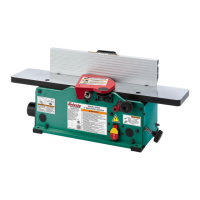Straightedge
Outfeed Table
Figure 41. Example of straightedge just touching
cutterhead body.
Straightedge
Outfeed Table Infeed Table
Figure 43. Example of infeed and outfeed table
height set evenly.
Black Lines Represent
Straightedge Positions
from Overhead View
Figure 44. Example of infeed and outfeed table
height set evenly.
Black Lines Represent
Straightedge Positions
From Overhead View
Figure 42. Straightedge positions for verifying
outfeed table parallelism.
-40-
Model G0945/G0946/G0947 (Mfd. Since 06/21)
4. Place straightedge on outfeed table so it
hangs over cutterhead, then rotate cutterhead
until straightedge just touches cutterhead
body (see Figure 41).
5.
Place straightedge in the positions shown
in Figure 42. In each position, straight-
edge should touch cutterhead and sit flat on
outfeed table.
— If straightedge touches cutterhead body
and sits flat across outfeed table in all posi-
tions, then outfeed table is already parallel
with cutterhead. Proceed to Checking
Infeed Table instructions.
— If straightedge does not touch cutterhead
body and sit flat across outfeed table in
any of the positions, then outfeed table
is not parallel with cutterhead. Perform
Adjusting Table Parallelism procedure
on Page 41.
3.
Place straightedge in the positions shown
in Figure 44. In each position, straightedge
should sit flat against both outfeed table and
infeed table.
— If straightedge sits flat against both
infeed and outfeed tables in all positions,
then tables are parallel. Install fence (if
removed) and cutterhead guard.
— If straightedge does not sit flat against
both infeed and outfeed tables in any of
the positions, then perform Adjusting
Table Parallelism on Page 41.
Checking Infeed Table
1. Follow all steps for checking outfeed table
parallelism to first make sure that outfeed
table is parallel with cutterhead.
2.
Rotate cutterhead so knives/inserts will
not interfere with straightedge, then place
straightedge on infeed and outfeed tables
and adjust infeed table even with outfeed
table, as shown in Figure 43.
Note: Infeed table depth-of-cut scale should
be set at "0".

